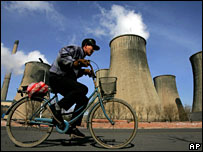Clean energy is 'cost effective'
 Using cleaner and more efficient energy not only helps the environment but also makes economic sense, according to the International Energy Agency (IEA).
Using cleaner and more efficient energy not only helps the environment but also makes economic sense, according to the International Energy Agency (IEA). However, nations are likely to stick to fossil fuels, leading to a “dirty, expensive and insecure future”, the IEA’s World Energy Outlook reported.
Using renewable power and nuclear energy could help the shift from fossil fuels, the agency said.
The greatest future demand for energy will stem from China and India.
Cost-effective
The World Energy Outlook, which looks at energy trends to 2030, says that the world faces two related energy threats.
One is inadequate and insecure energy supplies at affordable prices, and the other is environmental damage stemming from over-consumption of energy.
“The good news is that these [alternative] policies are very cost-effective,” said IEA executive director Claude Mandil.
“There are different upfront costs involved, but they are quickly outweighed by savings in fuel expenditure,” he said.
Each extra $1 invested in more efficient electrical equipment and appliances avoids more than $2 in power generation, transmission and distribution infrastructure, the report says.
The argument that switching to cleaner, more sustainable energy makes economic sense is being increasingly voiced.
The IEA report comes on the heels of the Stern report, commissioned by the UK government, which argued that extreme weather could shrink the global economy by 20%.
Demand
Based on the IEA’s alternative model, the agency forecasts that energy demand could be cut by 10% by 2030 - an amount equivalent to China’s current annual output.
One upshot of this scenario would be a 16% reduction in carbon dioxide emissions. The IEA is promoting nuclear energy as part of a ‘cleaner’ mix
But if nothing is done and energy demand continues, without underlying changes being made, primary energy demand would rise by 53% between 2006 and 2030.
The report identifies that underinvestment in new energy supply as a “real risk”. About half of all investment required is in developing countries, but “it is far from certain that this investment will actually occur”, the report said.
By 2010, China will be the world’s largest emitter of CO2, overtaking the US, the report predicts. Such an increase would “amplify the magnitude of global climate change”.
Other energy
As part of the proposed solution, the IEA says nuclear power could play a major role in reducing the reliance on imported gas and mitigate the impact of CO2 emissions.
“But financing the upfront investment cost may remain a challenge,” stressed Mr Mandil.
In addition, biofuels could play a significant role in meeting future energy needs for road transport, helping to diversify energy and reduce emissions.
You can return to the main Market News page, or press the Back button on your browser.

